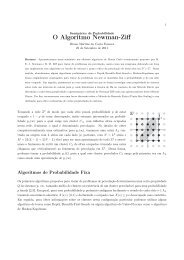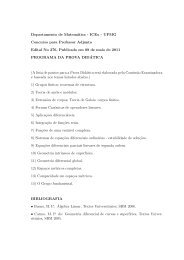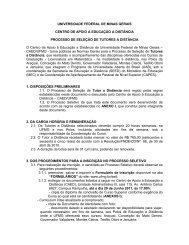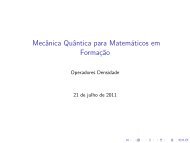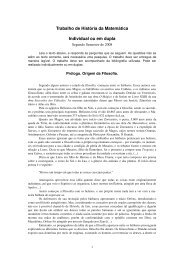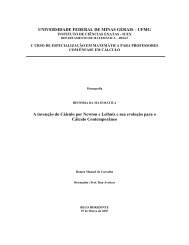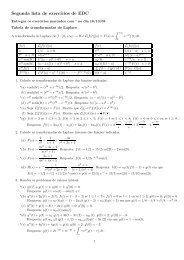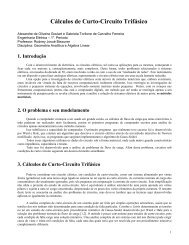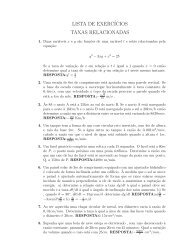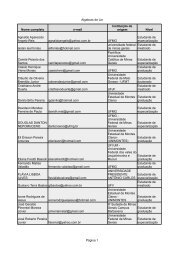Autovalores do Laplaciano - Departamento de Matemática - UFMG
Autovalores do Laplaciano - Departamento de Matemática - UFMG
Autovalores do Laplaciano - Departamento de Matemática - UFMG
Create successful ePaper yourself
Turn your PDF publications into a flip-book with our unique Google optimized e-Paper software.
Sumário<br />
1 Os <strong>Autovalores</strong> <strong>do</strong> <strong>Laplaciano</strong> 4<br />
1.1 Motivação para o Estu<strong>do</strong> <strong>do</strong>s <strong>Autovalores</strong> <strong>do</strong> <strong>Laplaciano</strong> . . . . . . . . . . . . . . . . . . . . . 4<br />
1.1.1 Méto<strong>do</strong> <strong>de</strong> Expansão em Autofunções . . . . . . . . . . . . . . . . . . . . . . . . . . . 4<br />
1.1.2 Problema Isospectral . . . . . . . . . . . . . . . . . . . . . . . . . . . . . . . . . . . . . 6<br />
1.2 Exemplos . . . . . . . . . . . . . . . . . . . . . . . . . . . . . . . . . . . . . . . . . . . . . . . 7<br />
1.3 Princípio <strong>do</strong> Máximo Fraco: O <strong>Laplaciano</strong> não possui <strong>Autovalores</strong> Negativos . . . . . . . . . 10<br />
1.4 Méto<strong>do</strong>s Variacionais para <strong>Autovalores</strong> <strong>de</strong> Opera<strong>do</strong>res Lineares . . . . . . . . . . . . . . . . . 12<br />
1.5 Os Espaços <strong>de</strong> Sobolev W 1,2 e W 1,2<br />
0 . . . . . . . . . . . . . . . . . . . . . . . . . . . . . . . . 14<br />
1.5.1 A Derivada Fraca . . . . . . . . . . . . . . . . . . . . . . . . . . . . . . . . . . . . . . . 14<br />
1.5.2 Espaços <strong>de</strong> Sobolev . . . . . . . . . . . . . . . . . . . . . . . . . . . . . . . . . . . . . . 16<br />
1.5.3 Proprieda<strong>de</strong>s <strong>do</strong>s Espaços <strong>de</strong> Sobolev . . . . . . . . . . . . . . . . . . . . . . . . . . . 16<br />
1.6 Existência e Unicida<strong>de</strong> <strong>de</strong> Soluções para o <strong>Laplaciano</strong> através <strong>do</strong> Méto<strong>do</strong> Variacional . . . . . 18<br />
1.6.1 Soluções Fracas . . . . . . . . . . . . . . . . . . . . . . . . . . . . . . . . . . . . . . . . 18<br />
1.6.2 Existência, Unicida<strong>de</strong> e Regularida<strong>de</strong> <strong>de</strong> Soluções Fracas . . . . . . . . . . . . . . . . . 18<br />
1.7 O Espectro <strong>do</strong> <strong>Laplaciano</strong> . . . . . . . . . . . . . . . . . . . . . . . . . . . . . . . . . . . . . . 21<br />
1.7.1 Existência e Caracterização Variacional <strong>do</strong>s <strong>Autovalores</strong> <strong>do</strong> <strong>Laplaciano</strong> . . . . . . . . . 21<br />
1.7.2 Comparação <strong>de</strong> <strong>Autovalores</strong> . . . . . . . . . . . . . . . . . . . . . . . . . . . . . . . . . 28<br />
1.8 Conjunto Nodal e Domínios Nodais <strong>de</strong> uma Autofunção . . . . . . . . . . . . . . . . . . . . . 30<br />
1.8.1 Princípio <strong>do</strong> Máximo Forte: o Primeiro Autovalor <strong>do</strong> <strong>Laplaciano</strong> é Simples . . . . . . 30<br />
1.8.2 Conjunto Nodal e Domínios Nodais <strong>de</strong> Autofunções <strong>do</strong> <strong>Laplaciano</strong> . . . . . . . . . . . 32<br />
1.9 Multiplicida<strong>de</strong> <strong>do</strong>s <strong>Autovalores</strong> <strong>do</strong> <strong>Laplaciano</strong> . . . . . . . . . . . . . . . . . . . . . . . . . . . 37<br />
2 Méto<strong>do</strong> <strong>de</strong> Diferenças Finitas 39<br />
2.1 O Caso Unidimensional . . . . . . . . . . . . . . . . . . . . . . . . . . . . . . . . . . . . . . . 39<br />
2.1.1 Séries <strong>de</strong> Taylor e Diferenças Finitas em Uma Dimensão . . . . . . . . . . . . . . . . . 39<br />
2.1.2 Discretização . . . . . . . . . . . . . . . . . . . . . . . . . . . . . . . . . . . . . . . . . 40<br />
2.1.3 Resolução Numérica <strong>do</strong> Problema <strong>de</strong> Autovalor Unidimensional . . . . . . . . . . . . . 42<br />
2.2 O Caso Bidimensional . . . . . . . . . . . . . . . . . . . . . . . . . . . . . . . . . . . . . . . . 44<br />
2.2.1 A Fórmula <strong>do</strong>s Cinco Pontos . . . . . . . . . . . . . . . . . . . . . . . . . . . . . . . . 45<br />
2.2.2 Existência e Unicida<strong>de</strong> da Solução Discreta – <strong>Autovalores</strong> <strong>do</strong> Problema Bidimensional 47<br />
2.2.3 Princípio <strong>do</strong> Máximo Discreto . . . . . . . . . . . . . . . . . . . . . . . . . . . . . . . . 51<br />
2.2.4 Convergência da Solução Discreta para a Solução Clássica . . . . . . . . . . . . . . . . 51<br />
2.3 Discretizações <strong>de</strong> Or<strong>de</strong>m Superior . . . . . . . . . . . . . . . . . . . . . . . . . . . . . . . . . . 55<br />
2.3.1 Caso Unidimensional . . . . . . . . . . . . . . . . . . . . . . . . . . . . . . . . . . . . . 55<br />
2.3.2 Caso Bidimensional: A Fórmula <strong>do</strong>s Nove Pontos Compacta . . . . . . . . . . . . . . 56<br />
2.4 Diferenças Finitas em Coor<strong>de</strong>nadas Polares . . . . . . . . . . . . . . . . . . . . . . . . . . . . 61<br />
2.5 Domínios Arbitrários . . . . . . . . . . . . . . . . . . . . . . . . . . . . . . . . . . . . . . . . . 65<br />
2.6 Exercícios . . . . . . . . . . . . . . . . . . . . . . . . . . . . . . . . . . . . . . . . . . . . . . . 67<br />
1




